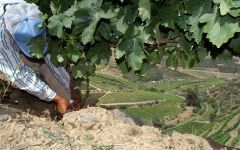Prats & Symington Chryseia Douro 2016
-
Wine
Spectator -
Wine
Enthusiast -
James
Suckling -
Wilfred
Wong -
Wine &
Spirits -
Robert
Parker



Product Details
Your Rating
Somm Note
Winemaker Notes
Professional Ratings
-
Wine Spectator
An impressive red that shows finesse to the generous profile of cherry tart, red plum and raspberry gelée notes, cast with licorice, Earl Grey tea, pepper and graphite details. Aromas of violet and mocha echo on the tannic finish. Needs a few years in the cellar. Best from 2021 through 2031.
-
Wine Enthusiast
Based on the magnificent Quinta de Roriz, this wine is a joint venture between the French Prats family and the Portuguese Symingtons. What has now become an icon wine is made with a nod to Bordeaux, richly structured while also elegant and layering tannins and fruit. It is obviously a wine to age, so wait until 2023.
-
James Suckling
A full-bodied red with aromas of blackberries, dried blackcurrants, cocoa, walnuts, dried porcini and dried herbs. It’s firm and structured with tight-grained, chewy tannins and bright acidity. Concentrated and tannic with savory character. Good length. 60% touriga nacional and 40% touriga franca. Drink or hold.
-
Wilfred Wong of Wine.com
COMMENTARY: The 2017 Prats & Symington Chryseia packs impressive fruit and power on the palate. TASTING NOTES: This wine brings excellent aromas and flavors of black fruit and complementary oak. Enjoy it with a grilled ribeye in a shallot-accented, wine reduction sauce. (Tasted: April 8, 2021, San Francisco, CA)
-
Wine & Spirits
A dynamic vintage of Chryseia, this wine takes Douro fruit toward silkiness without shedding the spicy schist distinction of its tannins or the dark flavors of the local varieties. Floral freshness lives in the silky texture, pointing up the blue and juicy black raspberry flavors while tannic freshness carries the wine’s power, structuring it for development over the next ten years. Charles Symington and Bruno Prats select the fruit for this wine from two estate vineyards, Quinta de Roriz and Quinta da Perdiz, including fruit from another Symington family property, Vila Velha. It’s destemmed and crushed, fermented in stainless steel and aged in new 400-liter French oak barrels, a winemaking regime that brings a Bordeaux perspective to Douro fruit.
-
Robert Parker's Wine Advocate
The 2016 Chryseia is a 60/40 blend of Touriga Nacional and Touriga Franca aged for 15 months in mostly (80%) new French oak. It comes in at 14% alcohol. This adds concentration, finesse and intensity to the Post Scriptum this issue, but it is most impressive for its pure essence of fruit. It doesn't seem jammy in terms of concentration, but as you let it sit on your palate, it sure does show off its intense fruitiness. There are no holes in the mid-palate as it finishes. This doesn't seem to me as lifted and as fresh as the 2015, but the concentration level may exceed it. The next question is always the hardest one: Will it turn into really more special as it ages? There, I have some doubts. Let's start here and be a little conservative. It may overtake the 2015 in time—and then again, it may not. It is more or less drinkable now but giving it a bit longer wouldn't hurt.
Other Vintages
2019-
Wine
Spectator -
Wine &
Spirits -
James
Suckling -
Robert
Parker
-
Wine
Enthusiast -
Wine
Spectator -
Wilfred
Wong -
James
Suckling
-
James
Suckling - Decanter
-
Wine
Spectator -
Robert
Parker -
Wine
Enthusiast -
Wine &
Spirits
-
Wine
Enthusiast -
Robert
Parker -
Wine
Spectator
-
Wine
Spectator -
Wine &
Spirits -
Robert
Parker
-
James
Suckling -
Wine
Spectator
-
Wine
Enthusiast -
James
Suckling -
Wine
Spectator -
Robert
Parker -
Wine &
Spirits
-
Wine
Spectator -
Wine
Enthusiast -
Robert
Parker
-
Wine
Enthusiast






With hundreds of red grape varieties to choose from, winemakers have the freedom to create a virtually endless assortment of blended red wines. In many European regions, strict laws are in place determining the set of varieties that may be used, but in the New World, experimentation is permitted and encouraged resulting in a wide variety of red wine styles. Blending can be utilized to enhance balance or create complexity, lending different layers of flavors and aromas. For example, a red wine blend variety that creates a fruity and full-bodied wine would do well combined with one that is naturally high in acidity and tannins. Sometimes small amounts of a particular variety are added to boost color or aromatics. Blending can take place before or after fermentation, with the latter, more popular option giving more control to the winemaker over the final qualities of the wine.
How to Serve Red Wine
A common piece of advice is to serve red wine at “room temperature,” but this suggestion is imprecise. After all, room temperature in January is likely to be quite different than in August, even considering the possible effect of central heating and air conditioning systems. The proper temperature to aim for is 55° F to 60° F for lighter-bodied reds and 60° F to 65° F for fuller-bodied wines.
How Long Does Red Wine Last?
Once opened and re-corked, a bottle stored in a cool, dark environment (like your fridge) will stay fresh and nicely drinkable for a day or two. There are products available that can extend that period by a couple of days. As for unopened bottles, optimal storage means keeping them on their sides in a moderately humid environment at about 57° F. Red wines stored in this manner will stay good – and possibly improve – for anywhere from one year to multiple decades. Assessing how long to hold on to a bottle is a complicated science. If you are planning long-term storage of your reds, seek the advice of a wine professional.

The home of Port—perhaps the most internationally acclaimed beverage—the Douro region of Portugal is one of the world’s oldest delimited wine regions, established in 1756. The vineyards of the Douro, set on the slopes surrounding the Douro River (known as the Duero in Spain), are incredibly steep, necessitating the use of terracing and thus, manual vineyard management as well as harvesting. The Douro's best sites, rare outcroppings of Cambrian schist, are reserved for vineyards that yield high quality Port.
While more than 100 indigenous varieties are approved for wine production in the Douro, there are five primary grapes that make up most Port and the region's excellent, though less known, red table wines. Touriga Nacional is the finest of these, prized for its deep color, tannins and floral aromatics. Tinta Roriz (Spain's Tempranillo) adds bright acidity and red fruit flavors. Touriga Franca shows great persistence of fruit and Tinta Barroca helps round out the blend with its supple texture. Tinta Cão, a fine but low-yielding variety, is now rarely planted but still highly valued for its ability to produce excellent, complex wines.
White wines, generally crisp, mineral-driven blends of Arinto, Viosinho, Gouveio, Malvasia Fina and an assortment of other rare but local varieties, are produced in small quantities but worth noting.
With hot summers and cool, wet winters, the Duoro has a maritime climate.
